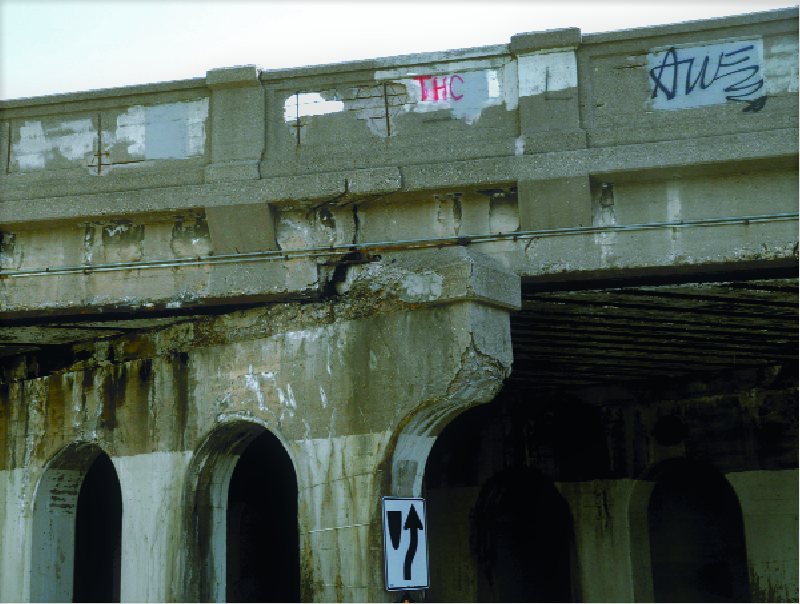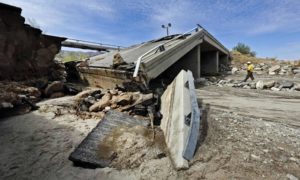The NEPA process, intended to create a better forum to resolve disputes, so projects could be built more responsibly, has instead become a powerful tool to delay/block projects from getting started at all. It is used regularly to delay/block road and bridge improvements, forest restoration, water projects, pipelines, powerlines, wind and solar installations, power plants, canals, locks, railroads, and harbors.
Waste Not, Want Not
CNN reports that “the fabric of America is crumbling,” quoting an American Society of Civil Engineers (ASCE) report giving a D+ grade to the country’s roads, bridges, airports, schools, and other public works. Melodramatic? The World Economic Forum now ranks the U.S. 13th in the world in maintaining adequate infrastructure, even below the United Arab Emirates and Singapore.
That concern prompted President Trump to prioritize such investments in his inaugural address: “We will build new roads, and highways, and bridges, and airports, and tunnels, and railways all across our wonderful nation,” he said.
ASCE estimates a $4.6 trillion need for maintenance and improvements over the next decade. Congress and the President agreed to spend almost half that on a new federal plan – in addition to state, local, and private projects. Almost 80 percent of public infrastructure projects are funded by state and local governments, so $2 trillion more federal dollars would have an overwhelming impact.
Critics often point out that of almost $80 billion in federal, state, and local fuel tax revenues (originally dedicated to roads and bridges), over 20 percent is now siphoned off for mass transit, landscaping, noise barriers, bike trails, and other uses. States also collect $38 billion in vehicle taxes, but spend 34 percent of it on non-highway uses. But that is not all the money being spent on purposes other than infrastructure. Indeed, we spend more on studies than on construction.
In January President Trump announced significant changes to the “NEPA process” which has generated significant controversy. Though few people understand details of the “National Environmental Policy Act” (NEPA), there is a widespread sense that it is important.
NEPA was enacted in 1970, to address a highway issue that had been festering for 15 years, since the beginning of the Interstate Highway System. Interstates were built through the heart of existing cities, and their destructive paths had prompted a series of “freeway revolts.” One survey said there were over a hundred protests in 1967-68. NEPA was supposed to address local concerns by requiring planners to address environmental and social impacts before construction began. Public protests faded, because there was (supposedly) a more effective process for opponents to be heard.
Under NEPA, project proponents are required to assess the environmental impact, and if it is considered serious, complete an “environmental impact statement” (EIS) analyzing alternatives. Agencies must seek “public comments” on proposed decisions, which can also be appealed, first to agency officers and ultimately to the courts. Projects with a lesser environmental impact could be handled with an “environmental assessment,” (EA) and simpler projects with a simpler “finding of no significant impact” (FONSI). Contrary to that original intent, today FONSIs are rare, and there is little difference in the size, scope, and cost between an EA and a full EIS.
In fact, in the five decades since NEPA, a massive industry has evolved, including attorneys, lobbyists, and consultants who get rich demanding full EISs, or more detailed EISs, writing EISs, challenging EISs, demanding more time for public comment, and suing the government. The NEPA process, intended to create a better forum to resolve disputes, so projects could be built more responsibly, has instead become a powerful tool to delay/block projects from getting started at all. It is used regularly to delay/block road and bridge improvements, forest restoration, water projects, pipelines, powerlines, wind and solar installations, power plants, canals, locks, railroads, and harbors. It plays right into the hands of BANANAs – people who want to “build absolutely nothing anywhere near anything.”
The resulting delays are staggering. The Council on Environmental Quality says from 2013 to 2017, the average EIS took over four years and filled 669 pages. The largest – so far – was for the 12-mile expansion of I-70 in Denver. That EIS took 13 years and (not including several preliminary drafts) was 8,951 pages long, plus 7,000 pages of appendices. Congress never intended for NEPA to become such a drag on progress.
Worse, the costs of such delays are appalling – nearly enough to finance the entire cost of the nation’s infrastructure repairs. A thorough study was completed by the group “Common Good” in 2017, estimating the costs of six-year delays on large projects (the national average). They amount to $3.7 trillion, counting such “social costs” as health injuries, traffic congestion, and environmental damages.
The Administration’s reforms would limit the full EIS process to two years and 300 pages, and preliminary “environmental assessments” to one year and 75 pages – as intended by the original NEPA law. Predictably, some opponents are demanding a six-month public comment period, rather than the required 90 days – not to provide more time for thoughtful dialogue, but to delay and circumvent it. They might win more time, but this reform needs to proceed. Americans have learned that when viruses and malware infest a system, it must occasionally be rebooted. After 50 years, NEPA needs a reboot.
An adage in the middle ages said, “Willful waste makes woeful want.” Methodism founder John Wesley simplified the proverb to “Waste not, want not.” We would be less in want of public improvements if we stopped wasting so much money studying them.
An edited version of this column appeared in the Grand Junction Daily Sentinel January 17, 2020.
See more from Greg Walcher here
Free Range Report
Thank you for reading our latest report, but before you go…
Our loyalty is to the truth and to YOU, our readers!
We respect your reading experience, and have refrained from putting up a paywall and obnoxious advertisements, which means that we get by on small donations from people like you. We’re not asking for much, but any amount that you can give goes a long way to securing a better future for the people who make America great.
[paypal_donation_button]
For as little as $1 you can support Free Range Report, and it takes only a moment.





Really appreciated this article but was disappointed that no mention was made of the effects of the EAJA paying for these radical environmentalist’s lawyers to prolong the NEPA process.